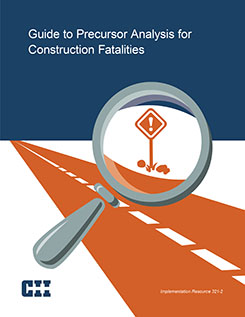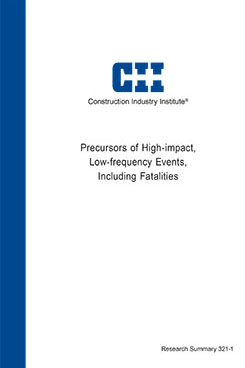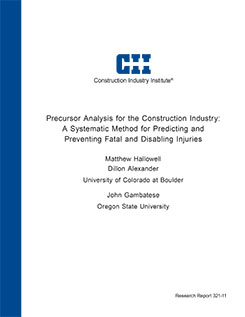
Guide to Precursor Analysis for Construction Fatalities
Publication No
IR321-2
Type
Examples of forms, paperwork, etc.
Publication Date
Oct 01, 2016
Pages
34
Research Team
RT-321
DOCUMENT DETAILS
Abstract
Key Findings
Filters & Tags
Abstract
Heinrich’s Pyramid Theory remains an often-cited model used in the description of injury experience. Unfortunately, this theory has led to a belief that less-severe events and fatalities are linked, which promotes expectations that improvement in the former will positively influence the latter. However, contemporary data contest this notion, and many high-performing organizations continue to experience fatal or near-fatal events. The current body of knowledge has thus far proven insufficient, and current prevention tools have proven ineffective.
The overall goal of RT-321 was to address the following essential questions: Are there precursors to HILF events on construction projects? If so, what are they, and how can they be identified, analyzed, and used in a predictive fashion in order to prevent the occurrence of HILF events? The team aimed to develop a predictive tool that would be used before work begins or while the work is being performed for relatively quick assessment of key work characteristics, personnel, plans, and environmental factors.
RT-321 completed a multi-phase research project that involved the following activities:
- reviewing literature, conducting root cause analyses of historic fatality cases, and undertaking research team brainstorming to generate a comprehensive list of potential factors that may be observed in a leading fashion and contribute to HILF events
- analyzing more than 500 past injuries to define “high energy” (i.e., the quantity of energy that can lead to a fatal incident) and provide guidance regarding when to implement the precursor analysis program
- creating a comprehensive protocol to collect information on these factors from case scenarios via a field-implementable questionnaire
- collecting data from fatal incidents, high-energy near misses, and successful cases of high-energy management
- conducting an experiment to assess the predictive validity of the precursor analysis program with experts from RT-321
- conducting statistical analyses of the cases collected, to validate empirically the precursor analysis tool and to reduce its length to only essential factors
- testing the precursor analysis tool by using less-experienced investigators with modest industry experience.
Key Findings
IR321-2, Guide to Precursor Analysis for Construction Fatalities
This Implementation Resource includes:
- Required foundation of safety management for precursor analysis
- Intended users who have the expertise necessary to implement precursor analysis
- When to implement precursor analysis based upon the concept of high energy (> 1,500 ft-lbs)
- Precursor analysis protocol involving a series of questions to ask of a crew and observations to make in order to identify precursors
- Precursor analysis scorecard provides a simplified method for identifying when work should be stopped because a high probability of fatal or disabling injury has been identified
- Methods for addressing precursors based upon the expertise of the research team
- An example case with actual responses, interpretations of responses, use of the scorecard, prediction, and recommended actions
Filters & Tags
Knowledge Area
Best Practice
Project Phase
Project Function
Industry Group
Research Topic
Using Precursor Analysis to Prevent Low-Frequency High-Impact Events, Including Fatalities
Keywords
Safety and health,
Precursor analysis,
Proactive safety,
Fatalities,
Probabilistic Risk Analysis,
High energy,
rt321



